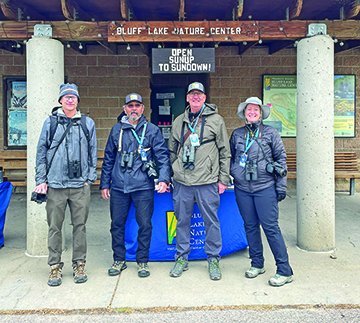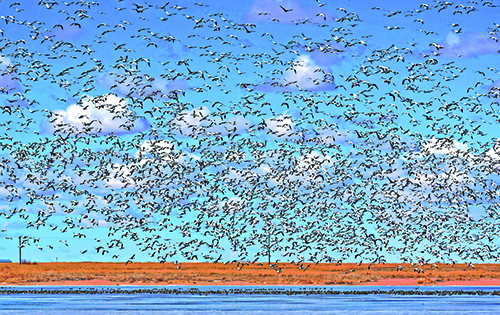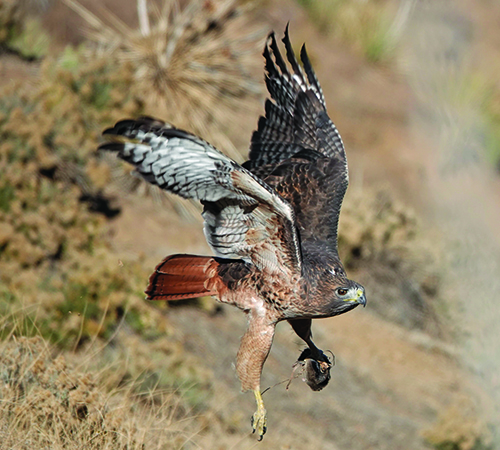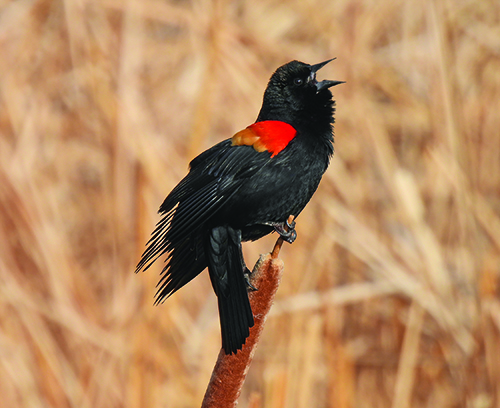by Jessica Hughes

Bird walk leaders at Bluff Lake Nature Center. Pictured from left to right: Jason Bidgood, George Ho, Steve Hebert, and Lisa Pera.

Thousands of snow geese flock to the reservoirs and farmland of the Eastern Plains. Photo by Jessica Hughes
Colorado is home to over 400 species of birds that either live here year-round or pass through during seasonal migrations. But when is the best time to see them? While most think of birding during warm-weather months, birdwatching is a year-round activity, with winter being one of the best times for viewing.
“Colorado winters are full of sunny, mild days which allow birders to enjoy the outdoors. Plus, the lack of leaves on the trees allows for better viewing of the birds,” says George Ho, Bluff Lake Nature Center Bird Volunteer/Monthly Bird Walk Leader. “Winter is great for birding.”
“There are plenty of ducks, geese, and raptors that migrate south to our parks and lakes to spend the winter in our (relatively) warm climate,” says Ben Jacques, Bluff Lake Nature Center Outdoor Explorers Program Coordinator. Also, since they must keep their bodies warm, they spend a lot of time moving around searching for food. This makes them easier to spot and hear through the bare foliage.”
“Plus, with shorter sunlight hours, good winter birding doesn’t require a 4 a.m. alarm,” says Jacques.
So, what should you expect to see? From the admired bald eagle to song sparrows, there is a variety of winter fowl to catch your eye. “Bald eagles are more plentiful in the winter here in Colorado because they come south to us from the north. Waterfowls like ducks are abundant in winter as well,” says Ho. “Winter sparrows are also popular to see. These include the white-crown sparrows and the juncos as well as the year-round song sparrows.”
He also says birds of prey are abundant, including owls like the great horned owls, hawks like the ferruginous, and the year-round red-tailed hawks, plus falcons like the prairie falcons and the American kestrels.
The best part is you don’t have to travel too far to see these beautiful birds in flight. Below are a few places close to home that make a great afternoon outing or a fun family day trip.
Bluff Lake Nature Center
Within Denver’s city limits, Bluff Lake Nature
Center is one of the best places for birdwatching in Denver. The 123-acre nature preserve has spotted 226 different species of birds according to their active community of birders who record their encounters.
For the beginners and families, the center offers bird walks throughout the year. Led by an expert guide, discover how and where to spot certain birds and learn about the different species you can find in Colorado. The walks are free, but you need to sign up in advance on their website. Download their printable birds of Bluff Lake checklist and keep track of what you spot.
Visit their birding page to learn more at www.blufflake.org/birdwatching
Cherry Creek State Park
Cherry Creek State Park is one of Colorado’s most popular parks due to its plethora of summer activities, but most may not think of it as a top birding spot. There are plenty of birds you can see year-round but in winter, soaring bald eagles perch high in cottonwood trees, while gulls meet around the marina and swim beach area. The reservoir eco-system also attracts raptors species including golden eagle, red-tailed hawk, northern harrier, and ferruginous hawk. Because the reservoir typically remains un-frozen throughout the winter, waterfowl and shorebirds are popular to see as well.
Barr Lake State Park
With more than 350 species of birds spotted, Barr Lake State Park is the metro area’s premier birding lake. About 30 miles northeast of Denver, Barr Lake offers one of the best set-ups for winter birdwatching. Walk the 8.8-mile trail that circles the lake, with several wildlife viewing stations and the wildlife refuge at the southern end of the lake. The lake’s large number of bald eagles, including a pair that nests there every year, are what draw in the birding crowds, both amateurs and experts.
Eastern Plains
Beyond Denver and the Front Range, the Eastern Plains create the ideal environment for bird watching in Colorado. The High Prairie and surrounding areas welcome over 40
0 species of birds including warblers, snow geese, grosbeaks, mountain plovers, and buntings. They make their homes amongst the grasslands, craggy outcrops, isolated ponds and reservoirs, plus rivers lined with cottonwoods and willows. There are 20 birding trails on the Eastern Plains featuring a variety of sites where you can view wildlife.
One of the most significant annual migrations in the state is the Snow Goose migration. Every winter, in January and February, the wind-swept plains and open-water reservoirs near Lamar, Colo., turn white, not with snow, but a swirl of 200,000+ snow geese descending upon the High Plains of Colorado. By way of the Western Central Flyway, the annual migration lasts up to two weeks and can be seen within state wildlife areas, local reservoirs, and area farms where they stop to feed.
High Plains Snow Goose Festival
In celebration of this migration, Lamar County hosts the annual High Plains Snow Goose Festival, taking place Feb. 3-5, 2023. As one of the largest birding festivals in Colorado, the event hosts a variety of programs, tours, and seminars that highlight the area’s landscape and unique birding heritage. Sign up for birding tours, shop the local craft fair, and listen to lectures to learn more about the migration and other local fowl. The event is free but tours and lectures require an advanced purchased ticket. For more information visit highplains snowgoose.com.
Birding Tips
The bird walk leaders at Bluff Lake Nature center say the best time to see birds is when they are most active, at dawn and dusk, when they are feeding. Patience and a good pair of binoculars are essential to get the most out of bird watching. “Plan your bird watching around a bird’s basic survival needs (food, water, and shelter) and you’re bound to get some birds in your binoculars,” says Jacques.
Jacques also suggests if you are new to birdwatching there are many beginner-friendly groups around Denver to join. The Denver Field Ornithologists, Denver Audubon, Bluff Lake Nature Center, Tuesday Birders, and multiple bird feeding stores run free bird walks in the area. Or download the free Merlin bird ID app by Cornell Lab for a great field guide on your phone.


